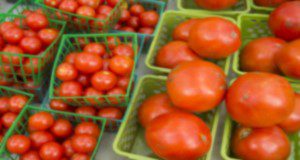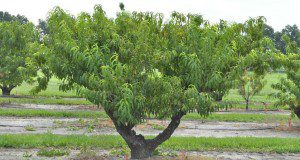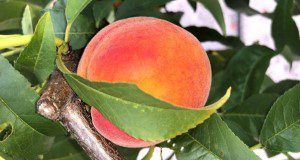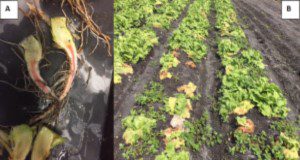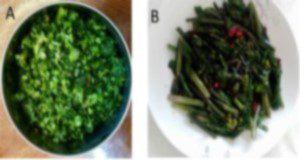Florida es el segundo productor de fresa más grade de los Estados Unidos, con un valor estimado de $337 millones. La siembra inicia entre finales de septiembre y mediados de octubre, en momentos donde las altas temperaturas representan un reto significativo para la sobrevivencia de los trasplantes, y por tanto también para el rendimiento y la calidad. El propósito principal de esta publicación es proporcionar recomendaciones basadas en resultados de investigación sobre métodos de establecimientos de trasplantes para productores de fresas en la Florida.
This new 5-page publication of the UF/IFAS Horticultural Sciences Department is the Spanish translation of HS1376, Methods for Strawberry Transplant Establishment in Florida. Written by Emmanuel Torres-Quezada, Lincoln Zotarelli, Vance M. Whitaker, and Shinsuke Agehara.
https://edis.ifas.ufl.edu/hs1378
Tag: Horticultural Sciences Department
Methods for Strawberry Transplant Establishment in Florida
Florida is the second largest strawberry producer in the United States, with an annual farm gate value of about $300 million. Planting occurs from late September through late October, and high air temperatures pose significant challenges for transplant establishment and thus yield and fruit quality. The primary purpose of this new 4-page publication of the UF/IFAS Horticultural Sciences Department is to provide research-based recommendations on transplant establishment methods for strawberry growers in Florida. The techniques presented are overhead irrigation application methods and practices, strawberry plugs and bare-root transplants, crop protectants, and reflective mulching. Written by Emmanuel Torres-Quezada, Lincoln Zotarelli, Vance M. Whitaker, and Shinsuke Agehara.
https://edis.ifas.ufl.edu/hs1376
Movement of Plant Nutrients
This new two-page document discusses soil-applied and foliar fertilization for citrus trees as well as mobile and immobile nutrients and how they affect the choice of fertilization. Written by Tripti Vashisth and Chris Oswalt, and published by the UF/IFAS Horticultural Sciences Department.
https://edis.ifas.ufl.edu/hs1373
Tomato Production in Florida Using Fertigation Technology
Tomato is in high demand because of its taste and health benefits. In Florida, tomato is the number one vegetable crop in terms of both acreage and value. Because of its high value and wide acreage, it is important for tomato production to be efficient in its water and nutrient use, which may be improved through fertigation practices. Therefore, the objective of this new 7-page article is to disseminate research-based methods of tomato production utilizing fertigation to enhance yield and nutrient use efficiency. Written by Mary Dixon and Guodong Liu, and published by the UF/IFAS Horticultural Sciences Department.
https://edis.ifas.ufl.edu/hs1392
Goji Berry: a Novel Nutraceutical “Superfruit” for Florida Master Gardeners
Goji berries have been used in both fresh and processed forms for food and medicine for more than 4,000 years in China. The goji berry fruit is known as a “superfruit” thanks to its high levels of vitamins and minerals, as well as other medicinal benefits recognized in many countries around the world. Most of Florida’s climate is favorable for goji berry, and a few Florida growers have cultivated it for years. This species can tolerate infertile and unfavorable growth conditions, and the prominent health benefits of this crop may be highly profitable for Florida growers. The objective of this new 7-page article is to provide a general overview of how the goji berry can be grown in Florida. Written by Yujie Jiao and Guodong Liu, and published by the UF/IFAS Horticultural Sciences Department.
https://edis.ifas.ufl.edu/hs1391
Elderberry and Elderflower (Sambucus spp.): A Cultivation Guide for Florida
The purpose of this new 9-page paper, written by David Jarnagin, Ali Sarkhosh, Juanita Popenoe, Steve Sargent, and Kevin Athearn, and published by the UF/IFAS Horticultural Sciences Department, is to provide information on growing American elderberry in Florida as an alternative crop for commercial growers as well as homeowners. Although elderberry has been historically grown at commercial scale in some world regions, especially throughout Europe, in the New World it has not found meaningful commercial acceptance until recently.
https://edis.ifas.ufl.edu/hs1390
Japanese Persimmon Cultural Practices in Florida
Persimmons are considered a relatively sustainable crop in Florida, rated as a 6 out of 10 on an assessment of agricultural sustainability, with a moderate commercial potential and high direct-to-consumer potential. Trees grow and fruit best in central and northern Florida and can produce high yields of good-quality fruit. This new 13-page publication of the UF/IFAS Horticultural Sciences Department describes how to propagate and establish persimmons in Florida, while also providing information on irrigation, fertilization, harvest, pests, diseases, and more. Written by Ali Sarkhosh, Dustin M. Huff, and Peter C. Andersen.
https://edis.ifas.ufl.edu/hs1389
Leek Cultivation Guide for Florida
Leek (Allium porrum L.) is a member of Amaryllidaceae, a family with ornamental crops, like amaryllis, and with vegetable crops, like onion. Leek is a highly demanded vegetable because of its flavor and nutrient content. Although there is great potential for leek to be grown commercially in Florida due to demand and appropriate climatic conditions, the United States does not currently produce a significant quantity of leek compared to countries such as Indonesia, Turkey, and China. This new 7-page publication of the UF/IFAS Horticultural Sciences Department, written by Mary Dixon and Guodong Liu, provides a basic guide to cultivation of leek in Florida, as well as information on its agricultural, culinary, and medicinal uses.
https://edis.ifas.ufl.edu/hs1388
Cultivares de Caqui Japonés en Florida
El caqui japonés, Diospyros kaki L., es originario de China y fue cultivado por primera vez en Florida en el año 1870. El número de fincas productoras de caqui en Florida ha aumentado de 164 a 227 durante el período 2012-2017, haciendo mayor hincapié en la naturaleza de pequeña escala de la superficie promedio de fincas en esta industria. Los árboles crecen y fructifican mejor en el centro y norte de Florida, y pueden producir altos rendimientos de fruta de buena calidad. En el sur de Florida, la calidad de los frutos de tipo astringentes es mejor que la de los de tipo no astringentes.
This new 12-page article is the Spanish translation of SP101/MG242, Japanese Persimmon Cultivars in Florida. Written by Ali Sarkhosh, Peter C. Andersen, and Dustin Huff; translated by Jonathan Clavijo Herrera; and published by the UF/IFAS Horticultural Sciences Department.
https://edis.ifas.ufl.edu/mg460
Guía para Cultivar Vegetales en la Florida
El desarrollo y planificación de un huerto en el hogar, es una actividad agrícola que puede realizarse durante todo el año en Florida. Puede ofrecer muchos beneficios para la salud física y emocional. Los huertos nos proveen alternativas para realizar ejercicios, disfrute del huerto, producción de vegetales frescos y nutritivos, ahorro económico y muchos otros. Esta guía proporciona recomendaciones para hacer un huerto en su residencia y comunidad, e incluye las fechas de siembra, la selección de variedades para la planificación de cultivos, el manejo de agua, nutrientes, plagas y la cosecha.
This is a translation of SP103/VH021, Florida Vegetable Gardening Guide. Written by Sydney Park Brown, Danielle Treadwell, J. M. Stephens, and Susan Webb; translated by Francisco Rivera; and published by the UF/IFAS Horticultural Sciences Department.
https://edis.ifas.ufl.edu/hs1383
Summer Pruning in Low-Chill Peaches Grown in Florida
Low-chill peach trees growing under Florida conditions can become vigorous and large. Summer pruning is a management strategy that can be applied to help restructure the canopy, direct the tree’s resources into fruit production, and improve the efficiency of fieldwork. Without summer pruning, peach orchards in subtropical regions will continue to grow vigorously and, if left unmanaged, will reach a point at which ladders will be required to harvest and maintain the trees. Summer pruning can be a means of reducing overall tree size, redistributing fruiting wood for easier harvesting, reducing disease pressure, and increasing fruit quality. This new 5-page publication of the UF/IFAS Horticultural Sciences Department, written by Ali Sarkhosh, Dustin Huff, Trequan McGee, and Juanita Popenoe, provides an illustrated step-by-step guide to summer pruning of peach trees.
https://edis.ifas.ufl.edu/hs1377
Oportunidades alternativas para fincas pequeñas: Producción de durazno y nectarinas versión revisada
El suave clima invernal de Florida y el comienzo de la temprano de primavera ofrecen oportunidades únicas para la producción de duraznos y nectarinas de temporada temprana. Durante los últimos 12 años, la Universidad de Florida ha lanzado muchos cultivares nuevos de durazno y nectarina. Estos nuevos y mejorados cultivares han aumentado el potencial de expansión del aspecto comercial de melocotones y nectarinas en gran parte de la península de Florida y en las regiones de la Costa del Golfo del sureste de los Estados Unidos.
This new 5-page article is the Spanish translation of RFAC018, Alternative Opportunities for Small Farms: Peach and Nectarine Production Review. Written by Ali Sarkhosh, Mercy Olmstead, Jeff Williamson, Jose Chaparro, and Juanita Popenoe, translated by Eva Pabon, and published by the UF/IFAS Horticultural Sciences Department.
https://edis.ifas.ufl.edu/hs1374
Fusarium Wilt: A New Threat to Florida Lettuce Production
Fusarium wilt of lettuce is a disease caused by the fungus Fusarium oxysporum f.sp. lactucae. The disease is present in all lettuce production areas worldwide. Recently this disease has been identified in Florida in localized fields. This new 4-page publication of the UF/IFAS Horticultural Sciences Department presents information about the disease, symptoms, and control measures useful to lettuce growers in Florida. Following these recommendations may help to avoid the spread of this fungus in muck soils at the Everglades Agricultural Area (EAA), where 90% of the lettuce in Florida is planted. Written by Germán V. Sandoya, Jesse J. Murray, Richard N. Raid, and Christian F. Miller.
https://edis.ifas.ufl.edu/hs1385
Recomendaciones para la Detección y Mitigación de la Marchitez del Laurel en Árboles de Aguacates y Especies Relacionadas en Jardines y Patios Hogareños
This is the Spanish translation of HS1358, Recommendations for the Detection and Mitigation of Laurel Wilt Disease in Avocado and Related Tree Species in the Home Landscape. Avocado trees are a popular choice for homeowners in Florida, with over 600,000 growing in Florida home landscapes. However, avocado trees as well as others in the Lauraceae family are susceptible to laurel wilt disease, which can kill a tree in as few as three weeks. This new 8-page publication of the UF/IFAS Horticultural Sciences Department provides home owners recommendations for identifying and mitigating laurel wilt disease in the home landscape. Written by Jonathan H. Crane, Jeff Wasielewski, Daniel Carrillo, Romina Gazis, Bruce Schaffer, Fredy Ballen, and Edwards Evans.
https://edis.ifas.ufl.edu/hs1384
How to Measure Leaf Disease Damage Using Image Analysis in ImageJ
This new 13-page article introduces simple image processing and analysis techniques to quantify leaf disease damage using ImageJ, an open-source image processing program. These techniques are not meant to replace crop scouting or disease diagnosis by a plant diagnostic laboratory, but rather to provide a supplemental tool for making quantitative measurements of leaf disease damage. Similar techniques are also available for plant growth assessment, including plant height, plant width, and canopy cover area. The image processing and analysis techniques introduced in this article are fairly simple to use and thus can be adopted not only by researchers, but also by producers, crop consultants, Extension agents, and students. Written by Lillian Pride, Gary Vallad, and Shinsuke Agehara, and published by the UF/IFAS Horticultural Sciences Department.
https://edis.ifas.ufl.edu/hs1382
Implementing the Five Rs of Nutrient Stewardship for Fertigation in Florida’s Vegetable Production
The five Rs of nutrient stewardship is a mnemonic device used to emphasize accuracy and precision for nutrient management so as to apply the (1) right source of fertilizer at the (2) right rate at the (3) right time in the (4) right place with the (5) right irrigation. Because the majority of Florida’s soils are sandy, this fifth R is imperative for sustainable nutrient management for commercial crop production. These main points of nutrient management (source, rate, time, place, irrigation) may help enhance sustainability by reducing pollution by eutrophication, nitrogen loss through ammonia volatilization, and climate change from soil greenhouse gas emission. This new 8-page publication of the UF/IFAS Horticultural Sciences Department was written by Mary Dixon and Guodong Liu.
https://edis.ifas.ufl.edu/hs1386
Production Guide for Choy Sum: An Emerging Asian Vegetable in Florida
Choy sum, also known as Chinese flowering cabbage, is a leafy vegetable that has been widely cultivated in southern China for more than 1,000 years, and is currently cultivated and consumed by a growing population in the western world. This new 5-page publication of the UF/IFAS Horticultural Sciences Department, written by Yanlin Wang and Guodong Liu, provides a brief overview of choy sum and its cultivation, as well as some suggestions for how to include it in a meal.
https://edis.ifas.ufl.edu/hs1380
Recomendaciones para el Control y Mitigación de la Marchitez del Laurel y sus Vectores, los Escarabajos Ambrosia, en Arboledas Comerciales de Aguacate en Florida
This is the Spanish translation of Recommendations for Control and Mitigation of Laurel Wilt and Ambrosia Beetle Vectors in Commercial Avocado Groves in Florida (HS1360). Laurel wilt and the ambrosia beetle vectors that transmit this lethal disease have and will continue to affect avocado production in Florida. At least 50% of the commercial producers are Hispanic Americans and some are more comfortable with publications in Spanish. The translator, Rubén Regalado, and reviewer, Carlos Balerdi, are both previous employees of UF/IFAS.
https://edis.ifas.ufl.edu/hs1379
Irrigation System Descriptions for Tropical and Subtropical Fruit Crops in Florida
Florida’s tropical and subtropical fruit crop industries use various irrigation systems, including high-volume systems designed for irrigation and freeze protection, drip systems for herbaceous fruit crops (papaya, banana), and microsprinkler types, mainly for irrigation and fertigation. There continues to be a steady stream of potential tropical and subtropical fruit producers in Florida, many with little to no knowledge of the various types or purposes of various irrigation system that have been used successfully for the past 60 years. This new 9-page publication of the UF/IFAS Horticultural Sciences Department includes potential producers, Extension faculty and agents, and irrigation companies. Written by Jonathan Crane, Haimanote Bayabil, Edward A. Evans, and Fredy Ballen.
https://edis.ifas.ufl.edu/hs1375
Daikon Radish Cultivation Guide for Florida
Daikon radish is a versatile vegetable crop in the mustard family. It produces a large, white, cylindrical fleshy root weighing up to 4-7 lb. Daikon radish is an especially common vegetable in Asia, particularly Japan, and it tends to be less spicy than other garden types of radish. This new 7-page publication of the UF/IFAS Horticultural Sciences Department provides a primer on cultivation of daikon in Florida, including sections on propagation, growing conditions, pests and diseases, and agricultural, culinary, and medicinal uses. Written by Mary Dixon and Guodong Liu.
https://edis.ifas.ufl.edu/hs1370


